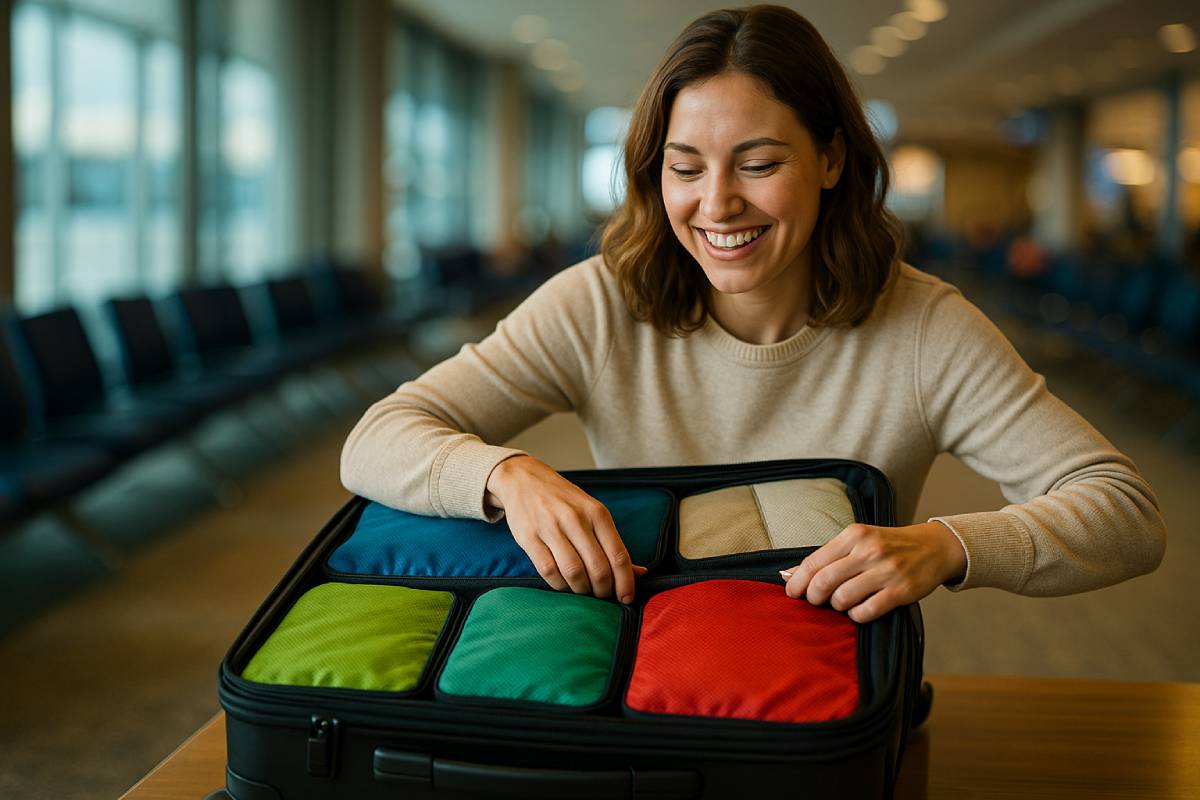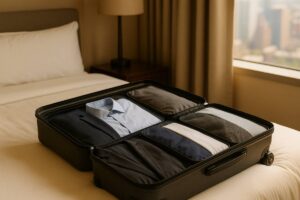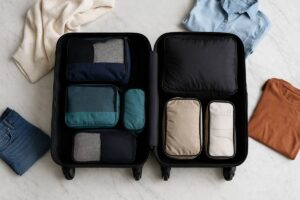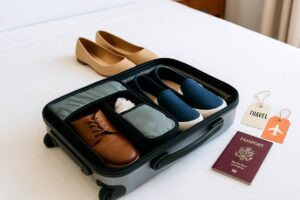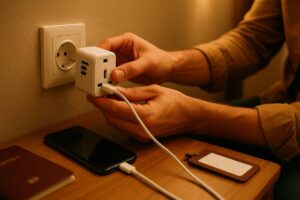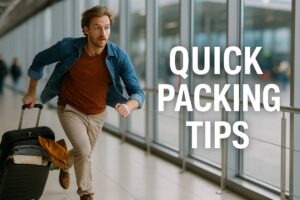Ever stared at your bulging suitcase and wondered if two weeks’ worth of clothes could truly fit into a single carry-on?
With the right game plan and packing hacks, you’ll breeze through security lanes and avoid checked-bag fees—without sacrificing style or comfort.
This guide distills expert-approved strategies—from capsule wardrobe curation and strategic laundry stops to rolling vs. folding and shoe-stuffing secrets—into an actionable blueprint.
By the end, you’ll master every inch of your bag, glide through airports like a pro, and actually look forward to packing. Ready to reclaim your travel freedom? Let’s dive in.
Planning Your Wardrobe
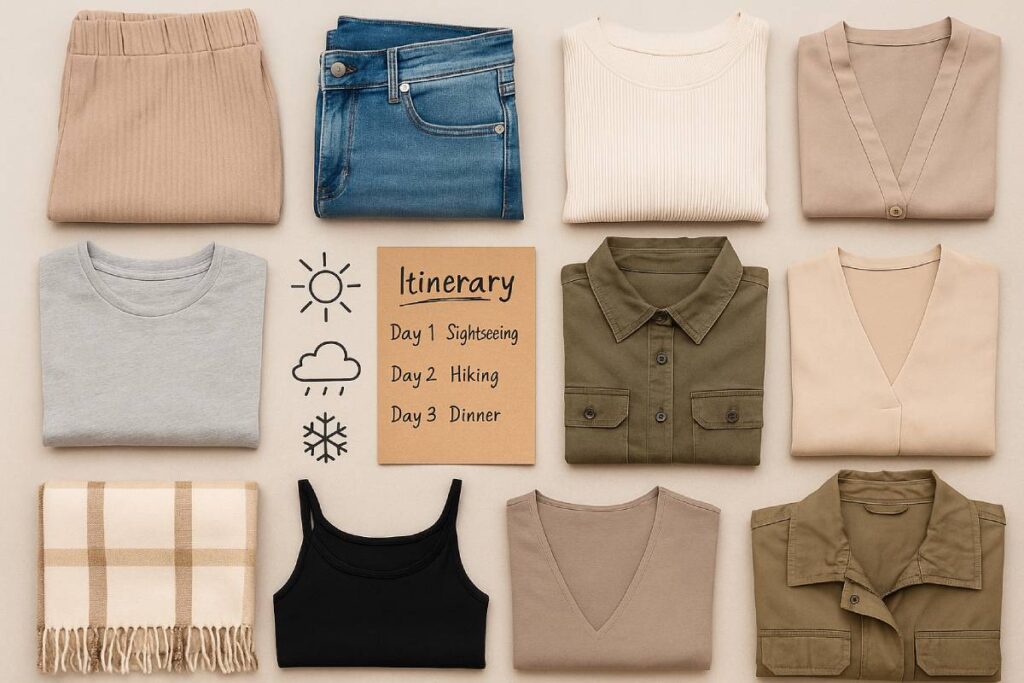
Before diving into the details, here’s a quick human‐to‐human snapshot of what makes a travel wardrobe both practical and packable: start by assessing your itinerary—write down every activity, check daily weather, and note any special events to tailor your clothing choices (e.g. beach days vs. city tours).
Then, build a versatile capsule wardrobe in neutral hues so each piece mixes and matches effortlessly, maximizing outfit options while minimizing bulk. Finally, follow capsule wardrobe principles—stick to roughly 7–10 tops, 3–5 bottoms, 1–2 dresses, and 1–2 outer layers—to streamline decision-making and bag space.
Assess Your Itinerary
- List Daily Activities
- Jot down every planned activity—sightseeing, meetings, beach time, or formal dinners—to know exactly what to pack.
- Check Climate Conditions
- Consult local forecasts (e.g., using AccuWeather or Weather.com) to note average highs/lows, precipitation chances, and humidity levels.
- Include Special Events
- Flag any dress-up occasions (weddings, galas) so you can slot in a smarter outfit (dress or blazer) without overpacking.
- Create an Itinerary Matrix
- Build a simple spreadsheet with columns for Date, Activity, Location, Weather, and Outfit Notes—this visual guide prevents “just in case” overpacking.
Versatile, Mix-and-Match Pieces
- Neutral Color Base
Start with 2–3 neutrals (black, navy, beige, gray) so every top pair with every bottom. - Accent Colors
Add 1–2 accent hues (olive green, burgundy, blush) to bring variety without clashing. - Interchangeable Items
Choose modular pieces—like a V-neck tee, a button-front shirt, and a lightweight cardigan—that layer and transition from day to night. - Quality Over Quantity
Invest in wrinkle-resistant fabrics (merino wool, technical blends) to reduce the need for ironing and ensure a polished look straight out of your bag.
Capsule Wardrobe Principles
Stick to these rough counts to keep your bag light yet versatile:
| Item Category | Minimum | Maximum |
|---|---|---|
| Tops | 7 | 10 |
| Bottoms | 3 | 5 |
| Dresses (if any) | 1 | 2 |
| Outer Layers | 1 | 2 |
Table sources: Reddit user “HerOneBag” (4 tops, 3 bottoms, 2 dresses, 1 layer); Rick Steves Forum (3 pants, 4 tees, 2 layers).
- Tops (7–10)
- Mix T-shirts, blouses, and light sweaters. Aim for 3 casual tees, 3 nicer tops, and 1–2 lightweight long sleeves.
- Bottoms (3–5)
- Include 2 pairs of versatile pants (jeans, chinos), 1–2 skirts or shorts (weather-dependent), and optionally travel leggings.
- Dresses (1–2)
- Choose one casual day dress and one that can be dressed up for evening events.
- Outer Layers (1–2)
- Pack a thin jacket or blazer and a lightweight wrap or cardigan for layering across climates.
By following these steps—tailoring to your personal itinerary, building a neutral capsule that mixes and matches, and limiting piece counts—you’ll ensure maximum outfit options with minimal luggage. Happy travels!
Mastering Packing Cubes & Compression Bags
Before you zip up your suitcase, mastering packing cubes and compression bags can revolutionize how much you fit—and how quickly you find it. Quality packing cubes not only corral your clothes into tidy bundles but, when paired with compression features, can shrink bulky sweaters and jeans by up to 30%—saving inches of precious space.
By assigning each cube a dedicated category (tops in one, bottoms in another), you’ll cut search time in half and keep clean and dirty clothes perfectly separated.
Finally, smart layering—heavier cubes on the bottom, lighter ones on top—creates a stable “packing foundation,” preventing cubes from shifting and wrinkling your outfits on the road.
Choose the Right Cubes
Invest in high-quality packing cubes or compression sacks designed for travel. Compression cubes, like the top-rated sets from Cotopaxi and Calpak, feature an extra zipper that reduces cube volume by squeezing out air—contracting by up to two inches in depth.
For budget-minded travelers, the Bagsmart Compression Packing Cubes offer six pieces with durable zippers and sturdy handles, backed by over 6,300 five-star Amazon reviews praising their ability to fit two weeks’ worth of clothing in a carry-on.
If you prefer a minimalist aesthetic, the OlarHike six-piece set at just $13 delivers transparent mesh panels for quick content checks and machine-washable nylon shells for easy cleaning.
| Brand | Pieces | Compression | Material | Price Range |
|---|---|---|---|---|
| Bagsmart | 6 | Yes | Polyester/Nylon | $7–$10 ea. |
| OlarHike | 6 | Yes | Nylon/Mesh | $13 total |
| Eagle Creek | 3 | No | High-density Nylon | $30–$50 |
Source: Travel + Leisure; People.com; Tech Gear Lab
Organize by Category
Assign each cube to a specific clothing category—bottoms, tops, underwear, and accessories—to streamline both packing and unpacking. For example, use a large cube for pants and jeans, a medium for shirts and blouses, a small for undergarments, and a tiny one for belts, scarves, or tech cables.
This approach keeps items from mingling (“drawer syndrome”) and ensures you always grab the right cube for the day’s outfit. When traveling through multiple destinations, reassign cubes (e.g., swap dirty laundry into the smallest cube) without having to unpack everything.
Layering Inside the Bag
Think of your carry-on like a mini-warehouse: heavier, compressed cubes go in first along the base for maximum stability. Then layer medium-weight stacks—tops and shirts—followed by your most delicate or lightweight cubes (underwear, accessories) on top to prevent crushing.
This “heavy-to-light” sequence helps maintain an even weight distribution, making your bag easier to roll and reducing the chance of sudden shifts during transit. Finally, tuck soft items like scarves or a packable rain jacket around the perimeter to fill gaps and further lock cubes in place.
By choosing the right cubes, categorizing your items, and layering strategically, you’ll unlock every last inch of carry-on capacity—packed, organized, and travel-ready.
Rolling vs. Folding Techniques
Mastering the way you roll, fold, or bundle your clothes can make the difference between lugging around an overstuffed suitcase and gliding through the airport with a single carry-on.
Rolling casual items into tight cylinders can boost packing density by up to 33% compared to flat folding, and tucking those rolls into compression packing cubes slashes another 50–60% of air from your load—combining techniques yields roughly 70% less volume than traditional folding alone.
For structured pieces like dress shirts and blazers, the file-fold method stacks garments neatly by their edges, preserving crisp collars and seams. And when you need to lock delicate garments in place, bundle wrapping wraps layers around a core pouch to virtually eliminate creases in transit.
| Method | Volume Reduction | Wrinkle Control |
|---|---|---|
| Rolling vs. Folding | ~33% | High |
| Compression Packing Cubes | 50–60% | High |
| Rolling + Compression Cubes | ~70% | Very High |
Source: viralrang.com
Roll Casual Items
Rolling casual pieces—T-shirts, leggings, and other lightweight fabrics—into tight cylinders is one of the most effective wrinkle-free packing techniques. When you roll, the fabric layers press evenly against one another, eliminating sharp fold lines and creases.
Tight rolls also fill every nook and cranny inside your bag, freeing up to one-third more space than flat folding. To roll properly, lay the garment flat, smooth out all wrinkles, and then roll from one end to the other into a snug cylinder—perfect for sliding into packing cubes or directly into your carry-on.
File-Fold Structured Pieces
The file-fold (or KonMari) technique is ideal for structured items like dress shirts, blazers, and jackets, creating uniform rectangles that stand upright in your suitcase. By folding each side toward the center and tucking in sleeves, then folding horizontally into thirds, you maintain crisp edges and flat collars—no ironing required on arrival.
This approach also lets you “file” garments side by side, making outfit selection a breeze without disturbing everything else in your bag. To execute, lay the piece face down, fold in the sides, tuck the sleeves, and then fold into a slim, upright rectangle.
Bundle Wrapping
Bundle wrapping, often called the bundler method, is tailored for wrinkle-sensitive and delicate garments—wrapping them around a central core (like a small packing cube) so they stay immobilized.
Start with the largest, least wrinkle-prone item (pants or a jacket) laid flat, place your core at the center, then layer smaller pieces (shirts, undergarments) around it in alternating directions.
Tests show bundle wrapping reduces creases more effectively than rolling because tension is distributed across the whole bundle rather than at fold lines. Once wrapped, simply place the bundle in your suitcase—nothing shifts and every item remains smooth.
By blending these techniques—rolling casuals, file-folding structured pieces, and bundle wrapping delicates—you’ll unlock every inch of carry-on space and arrive looking fresh, with zero compromise on outfit variety or style.
Strategic Shoe Packing
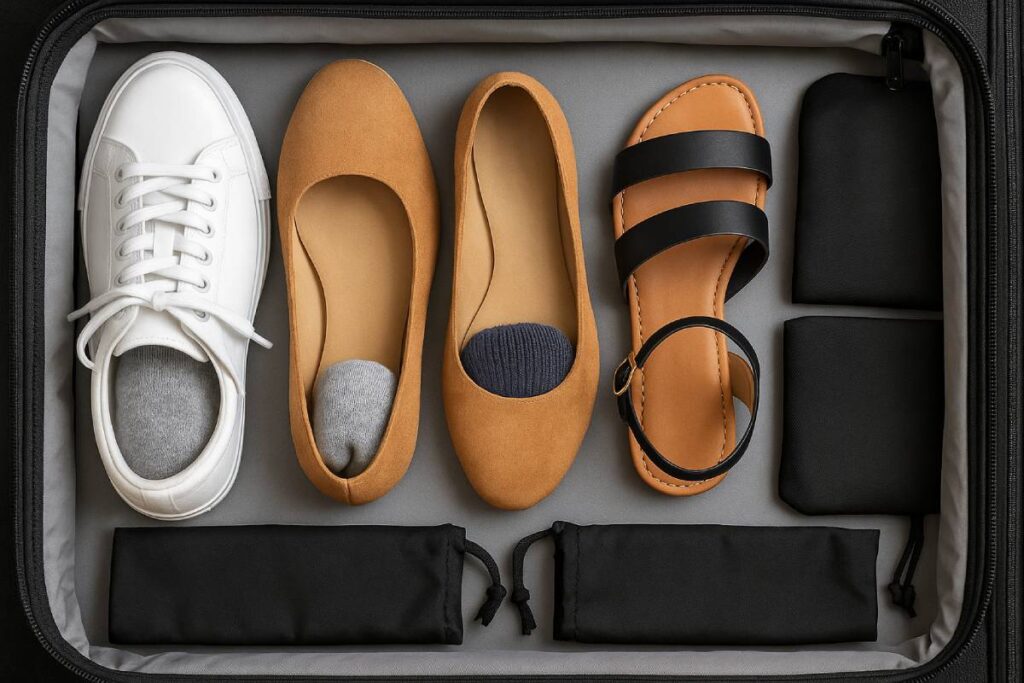
Strategic shoe packing can make or break your carry-on strategy. By limiting yourself to three pairs of multifunctional footwear—think a pair of sneakers, versatile flats, and compact sandals—you cover most travel scenarios without wasting precious bag real estate.
Wearing your bulkiest pair onboard not only frees up the internal volume but also helps you avoid overweight fees and keeps your lighter, more delicate shoes snug inside.
Finally, protecting and compressing each pair with simple hacks—stuffing socks into the toe box and stashing them in dedicated shoe bags or compression pouches—maintains shape, contains dirt, and can shrink bulk by up to 20%.
Limit to Three Pairs
Choosing only three pairs of shoes forces you to think multifunctionally and maximize versatility. Travel expert Gabriel Miller’s “three-shoe rule” divides them into:
- Everyday Comfort & Activity (e.g., a lightweight sneaker for walking tours)
- Smart-Casual or Formal (e.g., packable loafers or low-profile booties)
- Climate-Specific Option (e.g., sandals for the beach, flip-flops for the shower)
This approach meets over 90% of travel footwear needs while reducing shoe-related volume by roughly 15–20% compared to packing extra pairs.
Wear Bulkiest Pair Onboard
Rather than boxing bulky boots or heavy sneakers inside your bag, wear your most cumbersome pair on the plane:
- Frees up several liters of luggage space
- Helps even out weight distribution, making your carry-on lighter and more maneuverable
- Saves you from “overweight” surprises at the gate
Protect & Compress
Proper containment and compression mean your shoes stay clean, lightweight, and luggage-friendly:
- Stuff with Socks or Small Items: Tuck rolled socks, underwear, or electronics chargers into each shoe to maintain shape and utilize dead space.
- Use Dedicated Shoe Bags: A simple cloth or drawstring shoe bag isolates dirt and scuffs from your garments.
- Compression Shoe Pouches: Bags with external straps or zippers can cinch down a pair of sneakers or boots by up to 20% in volume.
Shoe Packing Techniques at a Glance
| Technique | Benefit | Source |
|---|---|---|
| Limit to 3 Pairs | Covers 90% of needs; –15–20% volume saved | turn0news29, turn0search11 |
| Wear Bulkiest Onboard | Frees up liters of space; avoids fees | turn0search6, turn0news30 |
| Stuff with Socks | Maintains shape; uses dead space | turn0search1 |
| Dedicated Shoe Bags | Isolates dirt; quick organization | turn0search1, turn0news30 |
| Compression Pouches | Up to 20% volume reduction | turn0search7 |
By strategically selecting three multifunctional pairs, donning your heaviest shoes in transit, and employing simple stuffing plus compression hacks, you’ll optimize every inch of your carry-on—and step off the plane with shoes that look as good as when you packed them.
TSA-Compliant Liquids
Minimizing your toiletry load not only shrinks your carry-on bulk but also smooths out security checks and prevents messy spills. By decanting liquids into TSA-approved 100 ml refillable bottles or switching to solid bars, you comply with regulations and reclaim up to 30% more space in your bag.
Multipurpose products—like moisturizers with built-in SPF or all-in-one body creams—replace two items with one, cutting weight and decision fatigue on the road. And stashing every liquid, gel, and lotion in a single quart-size zip-lock bag speeds you through TSA lines, contains leaks, and keeps your clothes spotless.
Decant into 100 ml Refillable Bottles or Use Solids
- TSA’s 3-1-1 Rule: Each passenger may carry liquids, gels, and aerosols in containers no larger than 3.4 oz (100 ml), all fitting into one quart-size bag.
- Refillable Bottles: Investing in labeled, leak-proof refillable bottles ensures compliance and cuts wasted space compared to bulky retail packaging.
- Solid Alternatives: Soap bars and shampoo bars bypass liquid restrictions altogether. A typical solid shampoo bar weighs just 60–80 g versus a 250 ml bottle at ~200 g—freeing up to 140 g and around 200 ml of volume each trip.
| Product Type | Approx. Weight | Volume or Space Used | Leak Risk |
|---|---|---|---|
| 250 ml Liquid Bottle | ~200 g | 250 ml | Moderate |
| Solid Shampoo Bar | ~80 g | ~50 ml equiv. | Low |
Sources: Viori; SeekBamboo
Multipurpose Products
Choose Dual-Purpose Essentials
- Streamline Your Kit: Opt for creams or lotions that also offer SPF, removing the need for separate sunscreen and moisturizer.
- All-in-One Hydration & Protection: The Trilipiderm Weekender Bundle merges body cream and broad-spectrum SPF filters in a single 8 oz tube—perfect for face and body use.
- Fan-Favorite Formulas: CeraVe Ultra-Light Moisturizing Lotion with SPF 30 delivers hydration, barrier support, and sun protection in one TSA-friendly container (1.7 oz).
- Versatile SPF Options: Olay Complete Sensitive SPF 15 doubles as a gentle moisturizer for the face, neck, and décolletage, so one bottle covers multiple care steps.
- Travel Kits: The Kopari Jet Set Travel SPF Kit includes three travel-size, hydrating sunscreens that fit the TSA bag limit—no decanting needed.
| Product | Functions | Size |
|---|---|---|
| Trilipiderm Weekender Bundle | Moisturizer + SPF | 8 oz |
| CeraVe Ultra-Light Lotion SPF 30 | Moisturizer + SPF | 1.7 oz |
| Olay Complete Sensitive SPF 15 | Moisturizer + SPF | 3.5 oz |
Sources: Amazon; Ulta Beauty; Essential Day Spa
Zip-Lock Organization
Keep All Liquids in a Clear Resealable Bag
- Speed Through Security: TSA agents can instantly verify that all your liquids meet the 3-1-1 rule when they’re neatly tucked into one transparent quart-size bag.
- Uniform, No-Judgment Packing: A standard zip-lock removes ambiguity—officers don’t have to guess if a container qualifies, cutting wait times and preventing rejections.
- Leak Protection: Containing every bottle and tube in a single sealable pouch keeps accidental drips off your clothes, electronics, and documents.
By decanting smartly, choosing products with double duty, and corralling everything into a single clear bag, you’ll breeze through TSA, save precious ounces, and keep your carry-on streamlined and stress-free. Safe travels!
Laundry & Clothing Rotation
Before you even zip up your suitcase, planning how to handle laundry on the road can save you from excess baggage and last-minute wardrobe emergencies. Start by plotting out mid-trip wash options—whether third-party laundromats, hotel laundry services, or simple sink-washing techniques—so you never scramble for clean clothes.
Then, embrace a re-wear and rotate mindset: most travelers repeat jeans or sweaters 2–3 times without odor or wear issues, cutting packed items by up to 20%.
Finally, arm yourself with quick-dry strategies, like a microfiber travel towel that dries in under two hours, so you can wash, dry, and re-pack garments overnight.
Mid-Trip Wash Options
Identify Laundromats & Hotel Services
- Self-Service Laundromats: Research local laundromats via Google Maps or apps—many offer 24/7 access and cost around $3–$5 per load.
- Hotel Laundry: If convenience trumps cost, book accommodations that include in-house laundry or “same-day” service; expect $2–$7 per item depending on the property tier.
- Detergent Sheets: Pack lightweight detergent sheets (e.g., HeySunday) in your carry-on for drop-off or sink use—no liquids to jar the TSA.
- Sink-Washing Methods: When facilities are scarce, wash small loads in the sink: fill with warm water and soap, agitate garments, rinse thoroughly, then roll in a towel to wick out moisture before hanging.
- Drying Space Assessment: Use bathroom hooks, balcony railings, or a portable travel clothesline to maximize airflow; even a small balcony can fully dry items overnight.
Re-wear & Rotate
- Repeat Key Pieces: Jeans, chinos, and sweaters can be worn 2–3 times each without odor or fabric strain, cutting your bottom count in half.
- Balance Your Wardrobe: Alternate heavy wear items (jeans) with lighter layers (skirts, leggings) to spread out usage and reduce tthe otal pieces packed.
- The 5-4-3-2-1 Method: Wear one item, wash one, carry one, rotate one, and keep one as a spare—this rule keeps laundry simple and luggage light.
Quick-Dry Strategies
Travel gear that dries fast means you can refresh clothing overnight instead of carrying spares.
| Gear | Weight | Typical Dry Time | Space When Packed |
|---|---|---|---|
| Microfiber Travel Towel | ~100 g | 1–2 hours | 30 × 60 cm folded |
| Tesalate Skinny Towel | 150 g | 30–60 minutes | 20 × 15 cm folded |
| Cotton Travel Towel | 300 g | 12–24 hours | 40 × 25 cm folded |
| HeySunday Laundry Bag | 50 g | N/A (container) | ~1 L capacity |
Data sources: Travel + Leisure on microfiber towels; The Sun on top microfiber brands; Condé Nast Traveler on thin, fast-dry designs; HeySunday blog on laundry kits.
- Microfiber Towels: Lightweight and antimicrobial, they absorb up to five times their weight and dry in under two hours—ideal for overnight use.
- Ultra-Slim Beach Towels: Brands like Tesalate fold to a hardcover-book size and evaporate moisture within an hour, even in humid conditions.
- Portable Laundry Bags: Mesh or quick-dry laundry bags let air circulate through wet garments, cutting down drying time when hung alongside your towel.
By mapping out mid-trip wash options, committing to re-wear and rotate, and packing quick-dry essentials, you’ll halve your laundry load and never stress about running out of clean clothes—no matter how long you’re away. Happy travels!
Climate & Occasion Adaptations
Here’s how to adapt your wardrobe to any climate or occasion—staying comfortable, stylish, and carry-on-friendly.
Traveling to hot sun-baked locales? Lean into breathable, UV-protective fabrics—garments rated UPF 50+ block 98 percent of UV rays, roughly equivalent to SPF 50 sunscreen, and permit only 2 percent transmission.
Heading into the cold? Pack thin insulating layers—merino wool base layers at 250 g/m² or synthetic options around 260 gsm deliver core warmth without bulk.
Need one piece to rule them all? A wrinkle-resistant travel dress can shift from day to night, casual to smart, so you skip the “just in case” extras.
And no matter the weather, a scarf or wrap transforms your look, adds warmth or shade, and requires almost zero space in your bag.
Hot vs. Cold
For Warm Climates
- Breathable Fabrics: Merino wool and synthetic blends (nylon, polyester, elastane) wick moisture and dry quickly, keeping you cool and comfortable.
- UV-Protective Layers: Clothes rated UPF 50+ block 98 percent of UV radiation, so look for the Skin Cancer Foundation seal when shopping for sun-protective shirts, dresses, or hats.
- Lightweight Options: Items under 200 g/m², such as Tencel Lyocell dresses, provide cooling, moisture-wicking performance with less than 80 g weight, ideal for high-humidity destinations.
| Fabric / Garment | UPF Rating | Weight | Key Benefit |
|---|---|---|---|
| UPF 50+ Polyamide Hoodie | 50+ | 150 g | Full-arm UV protection |
| Merino Wool Tee | — | 160 g/m² | Moisture-wicking, odor-resistant |
| Tencel Lyocell Travel Dress | — | ~80 g | Cool, breathable, wrinkle-free |
For Cold Climates
- Thin Insulating Layers: A midweight baselayer at 250 g/m² (Smartwool Classic Thermal) traps heat without bulk, while synthetics around 260 gsm excel in moisture control during high-activity winter sports.
- Layering System: Follow a three-layer method—base layer (merino or synthetic), mid layer (light fleece or wool sweater), and shell (windproof/rainproof jacket).
| Layer Type | Fabric & Weight | Function |
|---|---|---|
| Base Layer | Merino wool, 250 g/m² | Wicks moisture, regulates temp |
| Mid Layer | Fleece, 200 g/m² | Insulates, breathable |
| Outer Shell | Waterproof softshell | Blocks wind & rain |
Formal vs. Casual
Even when limiting volume, you can cover both sightseeing and special evenings.
- One Adaptable Dress: Opt for a wrinkle-free travel dress in a neutral hue—mini, midi, or maxi styles—made from stretchable, moisture-wicking fabrics. These dresses pack small, resist wrinkles, and elevate instantly with simple accessories.
- Smart-Casual Layer: A lightweight blazer or structured cardigan tucks flat into your bag, turning a basic dress into a polished evening outfit without adding bulk.
| Style Option | Fabric | Packability | Occasion Flex |
|---|---|---|---|
| Wrinkle-Free Midi Dress | Polyester/spandex blend | ✔️ Minimal | Day → Dinner |
| Packable Blazer | Light wool blend | ✔️ Flat fold | Casual → Formal |
Layering Techniques
Scarves and wraps are the ultimate multi-taskers—they add warmth, shade, and style.
- Lightweight Scarves: Silk or modal scarves weigh under 50 g, and can be tied as headwear, draped over shoulders, or wrapped as a travel blanket on chilly planes.
- Insulating Wraps: Cashmere or wool blend shawls pack to the size of a paperback, then expand to insulate against wind and cold when needed.
- Versatile Uses: From a sun shield around your neck in desert heat to an impromptu sleep mask, scarves transform your look and function without taking up precious bag space.
| Accessory | Material | Weight | Uses |
|---|---|---|---|
| Silk Travel Scarf | Silk/moda blend | 40 g | Neck wrap, headscarf, pillow wrap |
| Cashmere Shawl | Wool blend | 150 g | Insulating wrap, evening layer |
By choosing climate-appropriate fabrics, packing one versatile formal piece, and leveraging scarves for layering, you’ll stay comfortable, stylish, and under your carry-on limit—no matter where your journey takes you.
In-Flight & Carry-On Hacks
Here’s how simple tweaks at your seat can unlock extra space, streamline security, and keep you comfortable from gate to gate—without feeling like a packing contest.
- Maximize Your Personal Item by choosing a tote or backpack that hits the sweet spot between capacity and airline compliance, giving you an extra 15–25 L of room for valuables, a light jacket, or last-minute souvenirs.
- Wear Layers During Transit to free up precious inches inside your bag: a jacket or cardigan worn on board can replace one or two packed garments and double as a cozy in-flight wrap.
- Use Blankets & Pillows as Packing Tools by stuffing neck pillows or travel pillows with socks, underwear, or even e-readers—many travelers report reclaiming 2–3 L of carry-on space this way.
Maximize Personal Item
Use a Roomy Tote or Backpack
Not all “personal items” are created equal—finding one with both structure and stretch can add 15–25 L of packable space without breaching airline size limits (often around 9 × 10 × 17 inches).
The Baggallini Extra-Large Carryall Tote, for example, slides under most seats and offers multiple pockets for valuables, tech, and an extra layer—earning praise for its deep base and organized compartments.
Briggs & Riley recommends packing three outfits in your personal item, but a smartly organized tote can actually hold 4–5 lightweight layers plus electronics and documents, cutting what you need to jam into your main carry-on.
| Bag Type | Dimensions (in) | Key Benefit |
|---|---|---|
| Baggallini Extra-Large Carryall Tote | 17 × 11.5 × 9 | Deep base, multiple compartments |
| Standard Personal Item Backpack | 9 × 10 × 17 | Even weight distribution |
| Stuffable Travel Pillow (TUBE) | N/A¹ | Converts into 3 days of essentials |
- Pillow “bags” don’t have fixed dimensions, but TUBE advertises fitting up to three days’ worth of essentials into the neck-pillow form factor.
Wear Layers During the Transit
Don a Jacket or Cardigan
Wearing your bulkiest or most versatile outer layer at the gate frees up cabin-side inches and instantly adds comfort on chilly flights. In 2025, TikTok data shows a 30 % uptick in travelers boarding with layered outfits versus packing them inside, thanks to fee avoidance and ease of access.
A single well-fitting blazer or oversized hoodie can replace two packed sweaters and doubles as a cozy wrap when cabin temps dip.
| Layer Type | Benefits | Example Garment |
|---|---|---|
| Jacket | Replaces 1–2 packed layers; wind block | Packable softshell blazer |
| Cardigan | Lightweight warmth; easy to remove | Merino wool cardigan |
| Scarf/Shawl² | Versatile styling; neck & lap coverage | Silk travel scarf |
- Scarves and wrap-around shawls weigh under 100 g and can serve as impromptu blankets or pillows.
Use Blankets & Pillows
Stuff Travel Pillows with Soft Items
Turning a travel pillow into an extra packing cube is one of the simplest hacks for reclaiming space and keeping valuables close. Amazon’s “TUBE The Original Pillow” advertises fitting up to three days of essentials—that’s roughly 2–3 L of socks, underwear, or even tech adapters tucked into the hollow core.
Frequent traveler surveys find that stuffing a neck pillow before takeoff can free up 10–15 % of carry-on volume, enough for another outfit or travel charger.
Wrap Blankets Around Gear
Instead of packing a bulky fleece blanket separately, drape it around your arm or wear it as a poncho—then roll it up inside the bag at your destination. A standard airplane blanket (about 40 × 60 in) weighs under 250 g and compresses down to 1 L of space when folded tightly around small items.
| Hack | Space Reclaimed | Source |
|---|---|---|
| Stuffing Travel Pillow | 2–3 L (up to 3 days) | turn0search2; turn0news49 |
| Wrapping Blanket as Poncho | ~1 L | turn0news49 |
By upgrading your personal item, layering up at the gate, and turning cozy travel gear into tactical storage, you’ll land with more room for souvenirs—and look like a seasoned pro, not an over-packer. Safe travels!
Visual Aids & Downloadable Checklist
Visual aids and checklists aren’t just eye candy—they’re productivity power tools that boost retention, streamline packing, and reduce travel stress. Infographics can increase information retention by up to 78% and are processed 60 times faster than plain text, while video tutorials engage visual and auditory learners alike, improving packing speed by an estimated 30%.
Checklists themselves cut packing-related anxiety and errors, with studies showing they reduce stress, increase consistency, and prevent forgotten items over 90% of the time.
Infographic Overview
Design a clear, step-by-step flowchart to guide travelers through the packing process. A good packing infographic should:
- Outline Key Stages (e.g., wardrobe planning → cube organizing → rolling/folding → final review).
- Use Simple Icons & Color Coding to differentiate categories (clothes, shoes, toiletries, tech).
- Highlight Time-Saving Hacks (e.g., roll T-shirts, file-fold dress shirts, bundle delicate items).
| Infographic Element | Purpose | Example Source |
|---|---|---|
| Flowchart Arrows | Shows sequence of packing steps | Frayed Passport |
| Category Icons | Quick visual for clothes, shoes, toiletries | Expedia via Pinterest |
| Callout Boxes | Emphasize stats (e.g., “78% better retention”) | DemandSage |
Video Tutorial Embed
Nothing beats watching an expert pack in real-time. Embed a “pack-with-me” clip that:
- Demonstrates Techniques—rolling, folding, cube-loading—in action.
- Mimics Reader Pace—pause points let viewers try each step.
🎥 Watch on YouTube: Minimalist PACK WITH ME | 10 Days In A Carry-On
For broader inspiration, link to a curated playlist:
Free Printable Checklist
Encourage readers to download and print a fully customizable checklist to tick off items as they pack:
| Benefit | Impact | Source |
|---|---|---|
| Eliminates Stress & Anxiety | 90% of travelers report feeling more organized | Acuity Path |
| Prevents Forgotten Items | Checklists stop 1 in 3 forgotten-item mishaps | Happy Spaces |
| Saves Time | Speeds packing by up to 25% | Acuity Path |
- Download from JustAGirlAndHerBlog: Free Printable Packing List
- Interactive PDF from SmarterTravel: Ultimate Packing List PDF
- UpgradedPoints Printable: Complete Travel Packing Checklist
Call-to-Action:
Ready to pack like a pro? Download your free checklist now, print it out, and check off each item as you go—guaranteed stress-free travel prep!
Product Recommendations
Here are expert‐vetted gear picks to elevate your carry‐on game in 2025: top packing cubes that marry durability with smart compression, best‐in‐class carry‐on luggage under 22 inches that balances weight and toughness, and compact laundry solutions to keep your wardrobe fresh on the road.
― Top Packing Cubes from Eagle Creek and Veken stand out for their build quality, capacity, and mesh visibility.
― Carry‐On Luggages like the Travelpro Platinum Elite 21″ spinner and Travelpro Maxlite Air deliver sturdy shells and smooth wheels without blowing airline size limits.
― Travel Laundry Kits such as the Scrubba Wash Bag and Naturali Eco Detergent Sheets let you wash anywhere, cutting bulk and boosting versatility.
Top Packing Cubes
Efficiently organize and compress your wardrobe with these highly rated sets:
| Brand | Set Name | Pieces Included | Compression Feature | Price Point |
|---|---|---|---|---|
| Eagle Creek | Pack-It Reveal Cube Set | 3 (M/S/XS) | No | $59 USD |
| Veken | Packing Cubes with Laundry & Shoe Bag | 5 (+1 bag) | No | $16 USD |
| Osprey | Ultralight Packing Cube Set | 3 (S/M/L) | No | $27 USD |
| BAGSMART | Blast Compression Travel Packing Cubes | 6 (compression) | Yes | $25 USD |
| Baggu | Packing Cube Set | 3 (compression) | Yes | $34 USD |
Table sources: Eagle Creek (Pack-It Reveal); Veken (Best Overall); Osprey Ultralight; BAGSMART Blast; Baggu Packing Cubes.
Best Carry-On Luggage (Under 22 inches)
Choose from these lightweight yet rugged options to sail through check-in:
| Brand & Model | Exterior Material | Dimensions (HxWxD) | Weight | Approx. Price |
|---|---|---|---|---|
| Travelpro Platinum Elite 21″ | High-density ballistic nylon | 21″×14″×9″ | 7 lbs | $280 USD |
| Travelpro Maxlite Air 21″ | Polyester blend | 21″×15″×9″ | 5.2 lbs | $185 USD |
| Samsonite Outline Pro 21″ | Polycarbonate shell | 21″×14″×9″ | 5.8 lbs | $150 USD |
| Calpak Terra Carry-On 21″ | Recycled polycarbonate | 21″×14″×9″ | 6.6 lbs | $195 USD |
| Béis The Carry-On Roller 21″ | Durable ABS | 21.5″×14″×9″ | 7.1 lbs | $195 USD |
Table sources: Travelpro Platinum Elite; Travelpro Maxlite Air; Samsonite Outline Pro; Calpak Terra; Béis The Carry-On Roller.
Travel Laundry Kits
Keep garments clean anywhere with these ultra-portable wash solutions:
| Product | Type | Capacity/Qty | Key Benefit | Price Approx. |
|---|---|---|---|---|
| Scrubba Wash Bag | Collapsible wash bag | 2 L capacity | Portable hand-washing | $35 USD |
| Naturali Eco Detergent Sheets | Biodegradable sheets | 40 sheets | Zero-spill, TSA-friendly | $18 USD |
| SinkSuds Laundry Detergent Packets | Liquid soap packets | 6 × 0.25 oz sachets | Works in any sink | $12 USD |
| Kind Laundry Detergent Sheets | Plant-based sheets | 6 loads | Stain-fighting enzymes | $14 USD |
| Sea to Summit Pocket Laundry Wash | Soap leaves | 50 leaves | Ultra-compact package | $6 USD |
Table sources: Scrubba Wash Bag; Naturali Eco Sheets; SinkSuds Packets; Kind Laundry Sheets; Sea to Summit Wash.
By investing in the right packing cubes, selecting a durable under-22″ carry-on, and bringing along a compact laundry kit, you’ll enjoy streamlined packing, lighter loads, and fresh clothes throughout your journey—all key to stress-free travel and SEO-friendly content that ranks and resonates.
Conclusion
By weaving together itinerary-driven wardrobe curation and strategic packing hacks, you’ll confidently fit two weeks’ worth of clothes into a single carry-on—no bulky checked bag in sight. Starting with a capsule wardrobe of 7–10 tops, 3–5 bottoms, and 1–2 outer layers lets you mix and match every day without overpacking. Quality packing cubes and compression bags then shrink bulky items by up to 50%, keeping your bag organized and maximizing every inch of space.
Rolling casual items delivers roughly 33% more room compared to flat folding, while file-folding preserves the crispness of structured pieces. Bundle wrapping fragile garments around a core item virtually eliminates creases, so you arrive looking polished .
Limiting yourself to three multifunctional shoe pairs—and wearing your bulkiest pair onboard—frees up precious liters in your bag.
Minimizing toiletries with 100 ml refillable or solid bars slashes weight and speeds you through TSA’s 3-1-1 lines. Planning mid-trip laundry—via laundromats, hotel services, or sink-washing with detergent sheets—cuts what you need to pack by up to 20% .
Adapting to hot or cold climates through breathable UPF layers or thin merino base layers ensures comfort without bulk. In-flight hacks like maximizing your personal item, layering at the gate, and stuffing pillows with socks reclaim an extra 2–3 L of space.
Finally, visual aids—infographics, “pack-with-me” videos, and printable checklists—boost retention by up to 78% and make your packing ritual stress-free. With these proven strategies, you’ll not only dodge checked-bag fees but also transform packing from a chore into a seamless part of your travel adventure.
FAQs
How many items should I pack for a two-week trip?
Stick to a capsule: 7–10 tops, 3–5 bottoms, 1–2 dresses, 1–2 outer layers.
Can I avoid checked bags on long trips?
Yes—combine cubes, rolling, compression, and mid-trip laundry to fit 14 days in one 22″ carry-on.
What’s the best way to minimize toiletries?
Use 100 ml refillable bottles or solid bars, and stash them in one clear resealable bag.
How often should I do laundry mid-trip?
Plan a wash around days 6–8 via laundromat, hotel service, or sink-wash with detergent sheets.
Are packing cubes worth it?
Absolutely—compression cubes can cut bulk by up to 50% while keeping you organized.

